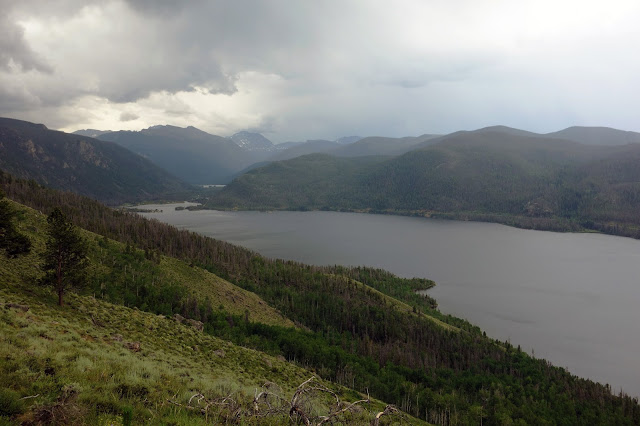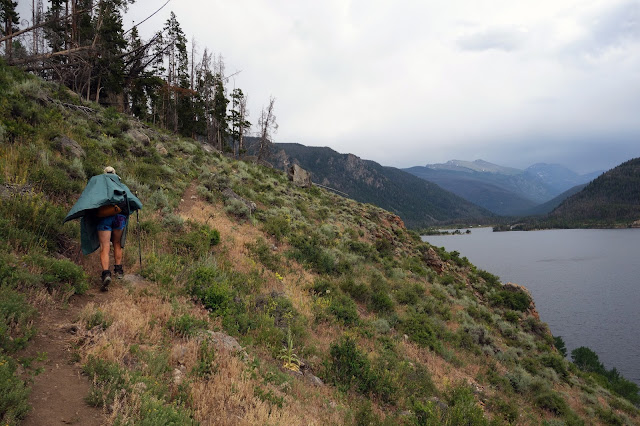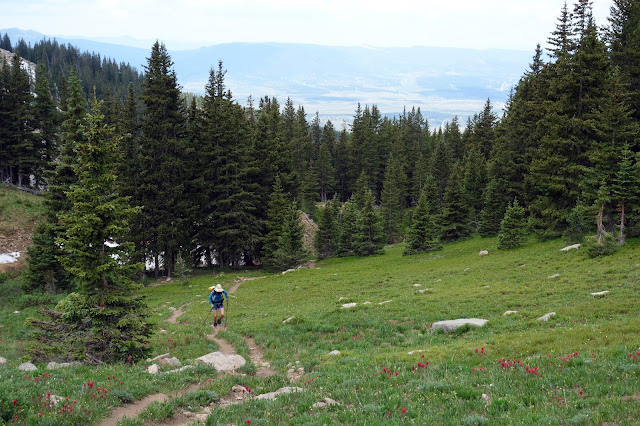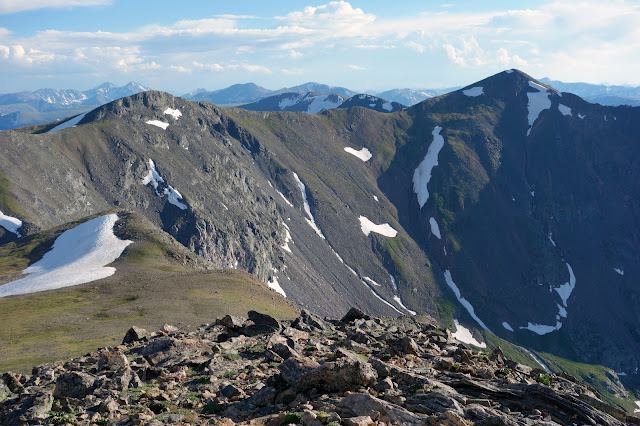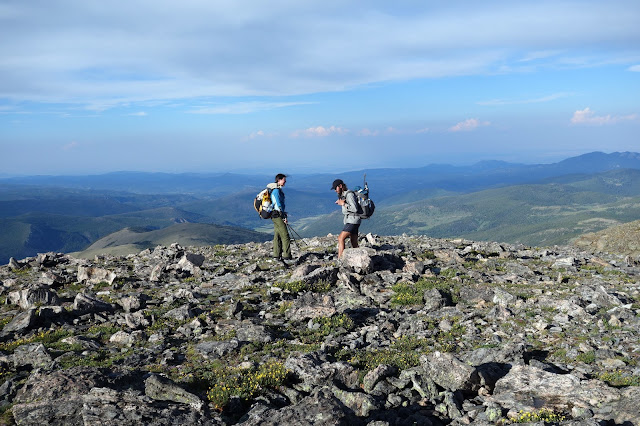On Monday I freaked myself out when I went to the gym and failed to lift the weights I'd managed the week prior. It wasn't a small slip. Last week I was doing three sets of 12 reps each, and this week I strained to eke out a single rep. A person secure in their health would probably just think, "Oh, I'm probably just tired from the backpacking trip." But my brain sent out all the alarm signals. "You finally ruined yourself with that backpacking trip! Your muscles are atrophied! You are dying, for real this time!"
I know I'm not dying. I mean, on the grand scale, yes I am dying. Even on the daily scale, there is a small chance I will die. But it's likely quite small. It's just that I haven't been feeling all that great since early June, and the insecurities build. My hair is falling out again. It probably won't all fall out, but it might. What will life be like as a bald woman? Do I care about my hair more than I care about breathing well, having a sharp mind and decent physical fitness? Well, no. But I do care. But it probably won't happen. But what if?
I try to keep this jittery negative feedback loop to myself, because if I complain, I will probably be laughed at. It's fair. I am blowing all of this out of proportion. There's a process and it takes time. Even my endocrinologist balked when I requested a blood test this month — she thinks I'm well enough to start having them every two months, and soon four. But I managed to schedule one on Wednesday. I find out the results next week. They're probably benign ... but what if?
So I avoided the urge toward gloom by recommitting to the gym — three times a week! Maybe four! — and not feeling bad about not going outside when it's hot and thunderstormy and polleny and buggy and grumble grumble summer. My winter. The "off season." Still, an opportunity presented itself to go for a longer ride on Thursday. I looked at a map, which always sparks curiosity — "oh, I haven't explored that road. Or that one. Or that one." A newfound excitement took over and soon I'd drawn a route topping 100 miles. Scratched a few things off. Brought it down to 70. "Seems doable."
Early in the ride my front tire sprung a leak and spewed out most of the sealant and air. It eventually sealed, but I only bothered to pump a little bit of air back in, and spent miles feeling anxious about springing another leak (and having to put in a tube! The horror!) I traced a largely abandoned forest road around Gross Reservoir and pondered how much of the forest would be leveled by a proposed expansion project. This led to unnecessary anger about the expansion project. From there I plodded west toward billowing cumulonimbus clouds that darkened and started dumping rain before noon. I was sheltered by forest and most of the electricity sounded far away, so I was grateful for the cooling deluge. My silly anxieties began to wash away.
The roads grew more rutted, steeper, and rockier. I began to struggle. And when I say struggle, I really mean struggle. I do not mean that my quads started to burn as I powered up the climbs. I mean that I pushed my bike for a dozen or so steps before stopping to catch a quick breath. Then I took a few more steps. My lungs felt ragged and I was dizzy. It took me nearly two hours to travel five miles. It was all quite silly. Why was I doing this? I plodded to a clearing at 11,000 feet and looked east. The storms had started to clear and the foothills were shrouded in haze — likely smoke from all the fires burning to the west. A grin spread across my face. I didn't even know why I was so giddy. It wasn't the most beautiful view, or the most unique. It was trees and hills and the world doesn't change all that much in the span of what, 25 miles? Is that all I'd ridden so far? Twenty-five miles? It felt as though I'd bashed my way through great hardship and emerged victorious at the top of a mountain. I think that's why I continue to seek out these efforts amid my limitations. In spite of them, if ever so briefly, I can experience a world without limits.
From there, all I needed to do was descend from 11,000 feet. I bounced over rocks and skidded on gravel as the road gradually widened and improved until I was screaming forward with that smile plastered across my face and cheeks burning from the windchill. Finally, the blurry world sharpened and I slowed to a roll at the bottom of the hill, where I realized I was in Central City. Central City is not close to Boulder. Not at all. I guess the map measured this route at 70 miles for a reason.
There was a bit of wheezing as I climbed a thousand feet and descended and climbed another thousand into Golden Gate State Park. Then climbed some more. All of those foothills I saw from up high — I pretty much had to climb all of them. Once I hit the flats, I still had twelve miles to pedal into town, largely into a headwind. Comparatively, this was coasting, and with 70 miles and 8,000 feet of climbing behind me, my lungs had relaxed and my legs were finally feeling a bit of pep. I was in a great mood, bolstered by Sia music:
"And I don't care if I sing off key.
I find myself in my melodies.
I sing for love, I sing for me.
I shout it out like a bird set free ..."
Have I been set free? Am I cured? Probably not. But I'm not imaginary dying, and that's what matters.
I know I'm not dying. I mean, on the grand scale, yes I am dying. Even on the daily scale, there is a small chance I will die. But it's likely quite small. It's just that I haven't been feeling all that great since early June, and the insecurities build. My hair is falling out again. It probably won't all fall out, but it might. What will life be like as a bald woman? Do I care about my hair more than I care about breathing well, having a sharp mind and decent physical fitness? Well, no. But I do care. But it probably won't happen. But what if?
I try to keep this jittery negative feedback loop to myself, because if I complain, I will probably be laughed at. It's fair. I am blowing all of this out of proportion. There's a process and it takes time. Even my endocrinologist balked when I requested a blood test this month — she thinks I'm well enough to start having them every two months, and soon four. But I managed to schedule one on Wednesday. I find out the results next week. They're probably benign ... but what if?
Early in the ride my front tire sprung a leak and spewed out most of the sealant and air. It eventually sealed, but I only bothered to pump a little bit of air back in, and spent miles feeling anxious about springing another leak (and having to put in a tube! The horror!) I traced a largely abandoned forest road around Gross Reservoir and pondered how much of the forest would be leveled by a proposed expansion project. This led to unnecessary anger about the expansion project. From there I plodded west toward billowing cumulonimbus clouds that darkened and started dumping rain before noon. I was sheltered by forest and most of the electricity sounded far away, so I was grateful for the cooling deluge. My silly anxieties began to wash away.
The roads grew more rutted, steeper, and rockier. I began to struggle. And when I say struggle, I really mean struggle. I do not mean that my quads started to burn as I powered up the climbs. I mean that I pushed my bike for a dozen or so steps before stopping to catch a quick breath. Then I took a few more steps. My lungs felt ragged and I was dizzy. It took me nearly two hours to travel five miles. It was all quite silly. Why was I doing this? I plodded to a clearing at 11,000 feet and looked east. The storms had started to clear and the foothills were shrouded in haze — likely smoke from all the fires burning to the west. A grin spread across my face. I didn't even know why I was so giddy. It wasn't the most beautiful view, or the most unique. It was trees and hills and the world doesn't change all that much in the span of what, 25 miles? Is that all I'd ridden so far? Twenty-five miles? It felt as though I'd bashed my way through great hardship and emerged victorious at the top of a mountain. I think that's why I continue to seek out these efforts amid my limitations. In spite of them, if ever so briefly, I can experience a world without limits.
From there, all I needed to do was descend from 11,000 feet. I bounced over rocks and skidded on gravel as the road gradually widened and improved until I was screaming forward with that smile plastered across my face and cheeks burning from the windchill. Finally, the blurry world sharpened and I slowed to a roll at the bottom of the hill, where I realized I was in Central City. Central City is not close to Boulder. Not at all. I guess the map measured this route at 70 miles for a reason.
There was a bit of wheezing as I climbed a thousand feet and descended and climbed another thousand into Golden Gate State Park. Then climbed some more. All of those foothills I saw from up high — I pretty much had to climb all of them. Once I hit the flats, I still had twelve miles to pedal into town, largely into a headwind. Comparatively, this was coasting, and with 70 miles and 8,000 feet of climbing behind me, my lungs had relaxed and my legs were finally feeling a bit of pep. I was in a great mood, bolstered by Sia music:
"And I don't care if I sing off key.
I find myself in my melodies.
I sing for love, I sing for me.
I shout it out like a bird set free ..."
Have I been set free? Am I cured? Probably not. But I'm not imaginary dying, and that's what matters.














